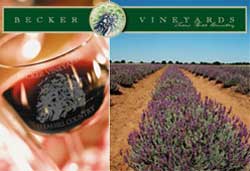
Mysterious Alchemy – The Aging of Wine: Part 3
Three Part Guest Blog by Michael Vilim
Michael Vilim is an Austin-based restaurateur with two first-class restaurants: Mirabelle and Castle Hill Cafe. He also serves on the Board of Directors for The Wine and Food Foundation of Texas, a charitable organization that supports scholarships for deserving culinary students and grants for deserving educational projects.
http://www.winefoodfoundation.org/
Part 3 – Texas Wine Selections and Aging: Suggestions from Michael Vilim, Jane Nickles (Texas Culinary Academy) and Russ Kane (VintageTexas.com)
Michael Vilim suggests:
McPherson Cellars
Syrah, Sangiovese, Cabernet Sauvignon. Small production but wines made for a very sophisticated palate, with excellent balance and weight. Not blockbusters, but medium to full bodied with good acidity and fine grained tannins. As someone who grew up on European wines, I like these wines out of the gate, but when serving them to friends, I like to give them a few months of ageing to soften and harmonize a bit.
 Becker Vineyards
Becker Vineyards
Always a source of great Texas wines, I understand Russell Smith is full time winemaker now and he is terrific and the Texas climate demands extremely skilled winemaking. Becker Vineyards is on the right tack. Certainly, the 2005 Cabernet Sauvignon Reserve is age worthy and may be just about the best red wine in Texas. I would like 1-2 years of aging. The other reds would benefit from 2-6 months: 2006 Grenache (Tallant Vineyard) and the 2006 Cabernet-Syrah Blend.
Alamosa Cellars
Again, a superb winemaker, Jim Johnson, with a wide range of wines including the 2004 El Guapo Tempranillo, and the 2001 El Guapo Grande Tempranillo. Both wines would benefit from more aging, although Alamosa has done much of the aging for us.
Stone House Vineyard
2006 Claros (Norton) I love this wine. It is the perfect food foil. Medium red with dusty black raspberry, good acidity and structure. Although it drinks well, it would benefit from 2-6 months aging.
Texas Hills Vineyards
2005 Kick Butt Cab is a wine that is big bodied and in your face. Grab a bottle if you find one, because its drinking really well now after a few years in the bottle.
 Flat Creek Estate
Flat Creek Estate
2006 Super Texan. Intense Sangiovese, that needs some time to mellow out, maybe 6-12 months. Of course, aeration and pairing with food will give the same effect and some aging.
Fall Creek Vineyards
2004 Meritus: Excellent balance, with 1-2 years of aging, the wine will put on weight and reveal all its power.
Jane Nickles (Texas Culinary Academy) suggests:
Texas Legato
They have a Petite Sirah that I have been known to describe as “looking like red crude oil in a glass”…that is delicious young but would definitely grow with age…
Inwoods Estates
They make both a Tempranillo and a Tempranillo-Cabernet blend that are meant to age, and the winery is very proud of the fact that the wines are barrel aged several years before bottling.
Of course, the many fortified ports and dessert wines drink well on release, but will hold with years of aging. I have always been fond of Messina Hof’s Papa Paulo Port Private Reserve
Russ Kane (VintageTexas.com) tasting notes:
I have had experience cellaring Texas wines since starting in the mid- to late-1990’s when I enetered the Texas wine experience and started organizing wine competitions. I have had good results with 5 to 10 years on a number of Texas premium red wines. These have typically been Cabernet Sauvignon, Cabernet blends (with Merlot and other Bordeaux varietals), Cabernet-Syrah blends and Cabernet-Sangiovese blends. Just about anything with Cabernet or Merlot from Newsom Vineyards in the Texas High Plains catches my eye since his fruit is the premium Texas experience and includes grapes from older vines.
Within the past 6 months, I have tasted the Fall Creek 1999 and 2002 Meritus from my collection: They were both exceptionally crisp with good acidity, and developing rich earthy qualities – both were non-over blown, medium bodied and well structured. I felt that the 1999 should not be taken further, but the 2002 had more to give as do the 2004 that I just added to my collection. I believe that these wines prove that acidity is a major key to wine aging, as Michael mentioned in his article.
 For a recent article, I opened bottles of Messina Hof 1998 and 2000 Papa Paulo Port Private Reserve. The 1998 had matured admirably during the first ten years with a collection of jammy elderberry fruit, soft and silky texture on the palate and toasted oak on the nose. The 2000 showed more like a younger wine including a spicy aromatic on the initiation often experienced with younger Ports made with Lenoir. No sediment was observed in either the 1998 or 2000. I have one more bottle of the 1998 that I plan to cellar to twenty years before opening. I will keep you posted.
For a recent article, I opened bottles of Messina Hof 1998 and 2000 Papa Paulo Port Private Reserve. The 1998 had matured admirably during the first ten years with a collection of jammy elderberry fruit, soft and silky texture on the palate and toasted oak on the nose. The 2000 showed more like a younger wine including a spicy aromatic on the initiation often experienced with younger Ports made with Lenoir. No sediment was observed in either the 1998 or 2000. I have one more bottle of the 1998 that I plan to cellar to twenty years before opening. I will keep you posted.
My cellar had a half case of the Flat Creek Travis Peak 2003 Cabernet Sauvignon. This was one of winemaker Craig Parker’s visionary wines that he proclaimed on the back label of the bottle age worthy to at least ten years. I served this wine initially in 2005 when first released and I opened two bottles at a dinner party in 2007. In 2005, it was a big dark fruit extraction and but with edgy tannins. In 2007, the wine was maturing and starting to achieve a softening of the tannins and their integration with the fruit that was holding up enjoyably well. I have two more bottles and I will try to wait until 2012 if I can.
While in Fredericksburg last week, I opened a cellar kept Becker Vineyards 2001 Cabernet Sauvignon Reserve – 7 years from vintage. It was a deep garnet in color and a smooth and slippery juice with developing mature aromas and flavors Michael described in his article. I think that it could still have 2 or 3 more years – 10 years of aging is my current limit, but only for the best Texas red wines. I say this because I opened a bottle of Blue Mountain Cabernet from the mid-1990’s that while still a substantial wine was on the downhill run.
One final interesting aging experience was with the Barking Rocks Cabernet Sauvignon (Newsom Vineyard) wine that won our 2004 Texas’ Best Wine Competition. This was the heftiest Texas wine I have experienced – a 2002 vintage, near-late harvest wine coming out with huge fruit supporting a wopping 15.5% alcohol. It was initially a lush and deep purple with fruit similar to some of California’s big Ridge red blends (Lytton Springs or Monte Bello) that I had tasted previously. After six years, the Barking Rocks Cabernet produced an even better intergrated tasting experience than in 2004. Its components were in alignment – still big fruit, but with aged qualities of leather and tobacco carried by an aromatic nose – great for a steak dinner or a slip on a cold winter night.
Right now, I am cellaring Texas Rhone- and Mediterranean-style wines and blends (both reds and whites) from McPherson Cellars, Alamosa and others. I am particularly interested in how Texas viognier from Brennan Vineyards and Alamosa’s Scissortail white blend will handle up to 5 years of age. I am still focusing on the old favorites, too – Becker Cabernet Sauvignon Reserve and Cabernet-Syrah, Llano Estacado Cellar Select Cabernet and Vivano (Cabernet-Sangiovese) red blend, Messina Hof’s Paulo (Bordeaux-blend) and Fall Creek Meritus (Bordeaux red blend). A new wine in my eye is Sandstone Cellars III.
P.S. I want to thank Michael and Jane for their contributions to this three part blog series. I also hope that you have found it interesting and informative. Please post your comments below or contact me directly (russ@vintagetexas.com) if you can share your own cellaring and aging experiences or with your thoughts for future blogs and guests to invite to VintageTexas.com for your edification and reading peasure.
Russ Kane

Be the first to comment